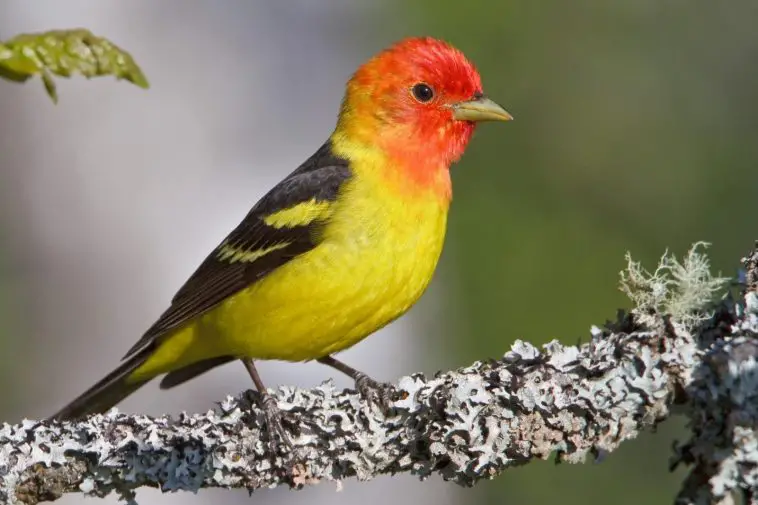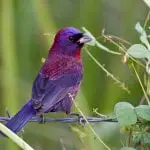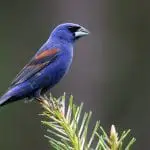Scientific Facts
| Common Name | Western Tanager |
| Scientific Name | Pinranga Ludoviciana |
| Length | About 18 cm |
| Life Span | Around 8 years |
| Clutch Size | 3 to 5 eggs |
| Habitat | Mixed or Coniferous Woods |
| Country of Origin | Mexico, United States |
Physical Description
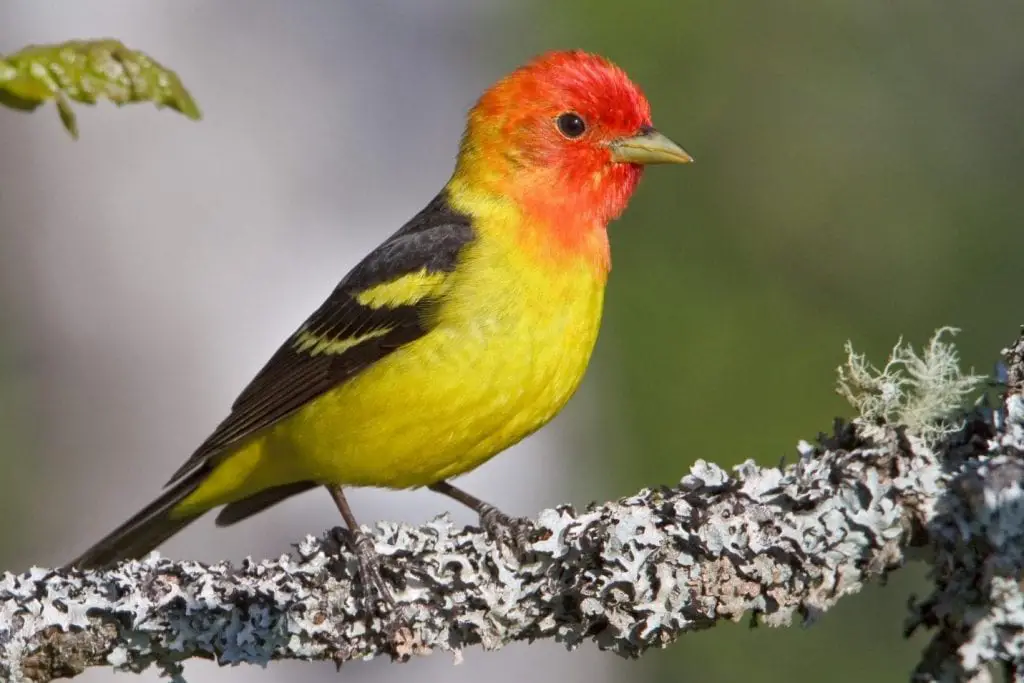
Adult western tanagers are medium-sized birds, with an average of about 18 cm in length, and an average weight of about 28 grams. Their wingspan is at 28 to 30 cm and features a fan-shaped tail and rounded wings. Their bill serves as an all-purpose beak, which means that using it, they can forage, build a nest, dig holes, preen, and even care for their young.
Adolescents have sepia brown eyes, while adult males have grayish-brown or black eyes. Adult males, on the other hand, have reddish-brown to burnt umber. Males have primarily yellow breast, with wings and back that are mainly black. These birds have a redhead.
The wings of western tanagers feature two bright yellow wing bars. The females are pale in color compared to males, with olive-green head and upper back. These birds also have grey wings, with two wing bars. Their tails are olive green or greyish brown. Young have pale gray or white down on their heads, wings, and back, with wing bars that usually become visible after the 10th day.
This species is hard to miss. With its bright red head, bright yellow underbody and neck, black wings, and two white bars, they are often viewed as beautiful, small to medium-sized birds.
Similar Species
There are three other species of tanagers in the US.
1. Hepatic Tanager
This species is a dull red-colored bird that lives in South America, and parts of Mexico all year throughout. However, they are also observed oftentimes to visit the mountains of Arizona, as well as New Mexico in summer.
2. Summer Tanager
Summer tanagers are a completely red bird that lives in South America and Central America. In summers, they migrate to northern Mexico and Southeastern US. They can also get into the mountainous regions of Southern Arizona.
3. Scarlet Tanager
Scarlet tanagers are noticeably beautiful with their bright red color and black wings. These birds are seen often in the eastern part of the US, in summers, and in Columbia and Ecuador in winters.
Adult western tanagers are not likely to be confused with other tanager species. In the southeastern part of Arizona, it may be confused with the flame-colored tanager, which usually features two white wing bars, white tips to their tertials, striped red-and-black back, and white-tipped tail feathers. The western tanagers have hybridized with the flame-colors.
Their offspring also has a mixture of flame-colored and western characteristics. Female flame-colored tanagers have a streaked back, bigger bill, and white tips to both tail and tertials. It should also be noted that some female scarlet tanagers show pale wing bars, though female western tanagers typically show a yellow upper bar.
Also, some worn western tanagers show little or no wing bar at all, but when compared with scarlet tanagers, western tanagers feature a grayer back, a larger bill, and a longer tail.
Interesting Facts
Here are some interesting facts on Western Tanagers:
- These birds breed farther north compared with other tropical bird species. They reach up to about 60 degrees North in the Northwest Territories.
- The red pigment on the face of these birds is actually rhodoxanthin, which is a pigment that is rare among birds. They are not naturally created by the bird, unlike the pigments usually found by other red tanagers. Rather, it comes from the diet, usually from insects that acquire such pigment from the plants.
- These birds were recorded first on the Lewis and Clark expedition, from 1803 to 1806.
- A group of western tanagers is known collectively as a “season.”
- Western tanagers are considered as summer birds that thrive in most locations in the United States and Canada. They typically winter in Central America and in Mexico.
- The primary component of their food is insects, though they often feed on fruits and berries in winter as well.
- Males are easier to recognize due to their bright red heads, yellow back and breasts, and black shoulders, wings, and tail.
- Their nesting period usually happens in early summer. Both parents are seen to collaborate in raising their chicks.
- Western tanagers are capable of occupying a wide range of ecosystems, including mixed conifer, riparian, Ponderosa forest, as well as backyard environments.
- These birds also feature a relatively small and light-colored bill, which makes it perfect for eating insects and fruits.
The Red Face
Western tanagers are observed to typically glean insects from branches and leaves, flying out to catch some aerial insects. This movement is often called sallying or hawking. The red face that makes western tanagers stand out is due to a substance called rhodoxanthin, which is a pigment that is found rarely among birds. This pigment is probably from the insect diet of these birds. In winter, the birds switch to berries, fruits, and nectar.
Habitat and Range
The breeding habitat of western tanagers is mixed or coniferous woods spread throughout the regions of North America from the Mexico and USA border, and as far north and the southern part of Alaska. As such, they can be classified as the northernmost breeding tanager species. These birds are migratory, wintering from central Mexico to Costa Rica. Some groups also winter in the southern parts of California.
The range for the breeding of this species includes forests that are located along the western coast of North America, specifically from Southeastern Alaska, then south to northern Baja California. They also extend to the east to Western Texas, and also north through the central part of New Mexico, extreme northwest Nebraska, central Colorado, as well as areas of western South Dakota and southwestern Northwest territories in Canada.
The wintering range of western tanagers stretches from the central part of Costa Rica, then towards the north through Honduras, Nicaragua, Guatemala, El Salvador to southern Baja California Sur, and the extreme southeastern Sonora parts in Western Mexico, and to the southern Tamaulipas in northeastern Mexico. They also do not occur typically in the lowlands of the Caribbean. They have been observed to winter further north, as well as far south as Panama.
This species arrive in their breeding grounds around spring, breeding in mixed woodlands and open coniferous forests. They leave their northern regions in late summer, spending their winters in the open mountain pine woodlands, gardens, parks, riparian areas, desert oases, and orchards. Within their wintering range, they also occupy pine-oak and pine woodlands, as well as low-canopied scrub forests. They have also been observed in elevations as high as 10,000 feet and as low as 330 feet.
Lifespan
Western tanagers have been recorded to live up to 15.3 years, though their average lifespan is at 8 years. Aside from predation, mortality among these birds may be caused by food deprivation, which comes as a result of severe weather.
Call and Song
The song of western tanagers is disconnected song phrases, suggesting a similarity to that of an American robin. However, the sound is hoarser and somewhat monotonous, with a call that can be described as “pit-er-ick.”
These birds communicate generally through song. Their calls are explosive and short and often used by both males and females, along with their young. The young birds sound more musical, and the females are often less eloquent.
A female tanager’s song is more repetitive, with about 2 to 5 phrases. The males, on the other hand, create more frequent, and more articulated vocalizations, with about 4 to 7 song phrases. The males primarily sign on their breeding grounds.
The male birds are usually attracted to the playback of female songs, even counter-singing, as they also hear nearby males. The rates of the song are most frequent in the morning while decreasing slowly throughout the day. When a female feels a threat, she is also observed to make a series of obvious nervous calls. As soon as the male hears that call, he also gives a loud series of nervous calls, flying from one branch to another.
Feeding and Diet
Western tanagers are described as insectivores. They catch insects while flying. While vespid wasps are not usually considered as food by other migratory birds, they are loved by western tanagers. They also eat nectar from plants and fruits. In winter, they eat both fruits and insects.
During the breeding season, these birds usually eat insects, especially ants, wasps, stinkbugs, termites, beetles, cicadas, crane flies, caterpillars, dragonflies, sawflies and scale insects. Before these birds swallow dragonflies, they usually clip the wings of the insects, and the head and legs, occasionally.
They also eat fruits, especially during winter and fall, when these food items dominate their diet. Among the fruits that they eat include wild cherries, hawthorn, blackberries, elderberries, serviceberries, and mulberries. Buds, like those from the greasewood bushes, add variety from time to time. Winter visitors have also been observed eating seeds at bird feeders.
Behavior
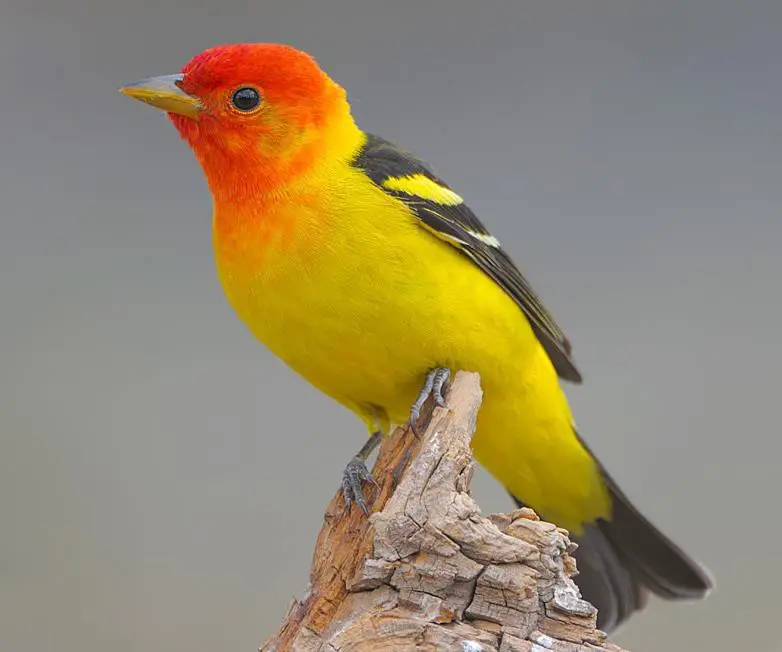
Western Tanagers either migrate alone or in groups, reaching about 30 individuals. On the average, hatching-year birds were captured at Rio Grande Nature Center later than adults during their fall migration. The timing of migration, bird condition, and differences in the site during spring and fall migration were also considered during the investigation.
These birds were observed to arrive on their breeding grounds at springtime. The breeding usually happens among two years or older birds, starting in May until July. Some first-years are also observed to breed. In locations such as in North Central New Mexico and the Sandia Mountains, these birds were heard singing starting in late May, while their first nest was found in early June.
In open space, public areas in Colorado, the start of their breeding season was estimated to be on May 28, while the peak of such breeding season was from early June to early July. Brooding may start earlier in Alberta and British Columbia than in the northwestern part of the United States.
Migration usually happens at night, and at high altitudes. They typically establish loose associations with other species of birds, including purple finches, Townsend’s warblers, and mountain chickadees. The males usually chase other males intruding their territory, while females also chase other females.
Western tanagers also chase smaller birds. Physical contact is, at times, done as a result of the reaction of the surprised victim. These birds may be difficult to locate since they forage in the upper tree branches, moving deliberately and slowly. In-flight, however, they are direct and swift.
A few studies have been conducted in the home territories of western tanagers. A conifer forest located in Idaho has an average home range size of 39,100 square meters. In Montana, they also have an average home range of 28,300 square meters.
After they return to the breeding areas, the male western tanagers will establish territories through nonstop singing, particularly at the territory borders. Both females and males work in chasing away their intruders. A male bird is often observed to stay close to his mate during egg laying and nest building, and the pair is almost always beside each other when the female is not sitting on the nest. Sometimes, the males are observed to feed the female at or close to the nest.
Reproduction and Nesting
Western tanagers are described to be monogamous. The pairs are created during migration, as well as on their wintering grounds. Pairs that are formed on the wintering grounds may choose to migrate together to the breeding grounds. The males’ role involves establishing and defending their territory by chasing or singing away their intruders. However, male birds are not observed to show-off in order to attract mates.
The earliest birds to arrive on the breeding grounds usually do so in April, while the others in their group arrive by early May. On average, females, along with first-year males, arrive later at the breeding grounds. Both males and females mature sexually after two years. Even though these birds are socially monogamous, the males are observed to move out of the territory that they defend in order to mate with other females.
The nests are built by the female, in a cup shape. It usually takes about 4 or more days to create, and are constructed using rootlets, twigs, grasses, as well as pine needles. No evidence has been found for second broods among western tanagers. The laying of eggs usually takes one day per egg. The female takes care of the incubation of the eggs for about 13 days, even though there have been some reports of shorter incubation periods.
During the nest building, males feed the females, as well as during the egg-laying process. The young are cared for and fed by both parents. They usually fledge around 11 to 15 days after hatching. Young birds have been observed with their parents at least two weeks after they fledge. In terms of the order, immature birds start migration later than adults. The breeding success among western tanagers widely varies between reports and throughout the years.
The eggs are about 23 mm in length and weigh about 3.35 grams. They are either bluish-green or pale blue in color. The eggs have brownish speckles and blotches that form a thick wreath surrounding the larger end of the egg. These birds can survive for several years. In the wild, this species can live up to 7 years.
Roles in the Ecosystem
Western tanagers are prey to many mammals and birds. For example, brown-headed cowbirds are common parasites to the nests of these birds, reducing the population of birds that fledge from the nests. These birds are known to mob cowbirds, with the latter observed to remove some of their eggs, even laying their own in the nest. After hatching, the tanagers continue to raise the cowbirds to fledge. Fledglings are also known to be invaded by blowfly larvae, often resulting in death.
On a positive note, western tanagers eat several insects. As such, they are recognized as s form of pest control. There are also no recognized negative effects of the presence of western tanagers, especially on humans.
Predation
Several birds consider western tanagers as their prey. Among their common predators include owls, hawks, and jays. They also have nest predators, which include black bears, jays, owls, bull snakes, prairie rattlesnakes, American crows, squirrels, common ravens, as well as domestic cats.
Anti-predator strategies are also adapted by western tanagers. This includes wing flapping, tail cocking, usually accompanied by loud, nervous calls. They are also observed to swoop towards their intruders when they are in close proximity to their nests.
Conservation Status
Western tanagers are not classified as a threatened species. As a matter of fact, they have quite a large range. They rate an 8 out of 20 on the Continental Concern Score and are also not included on the 2014 State of the Birds Watch List. They are also protected under the U.S. Migratory Bird Act. According to the report presented by the North American Breeding Bird Survey, an increase in their numbers was seen between 1966 and 2014. It has been estimated that the global breeding population of this species is at about 11 million, with 68% of their population spending time in the United States, and 32% in Canada, while 75% are in Mexico.
These birds thrive in open habitat, as well as in edges of the forest interior, while not requiring large forest patches for breeding. As such, they have fared better compared with other species in response to fragmentations in forests. Sine western tanagers are associated closely with Douglas-fir forests found in the interior west, practices in management in these forests will also be considered as important.
Tips to Attract Western Tanagers
Even though these birds do not eat seeds typically, they may also eat dried fruit, fresh fruits, and freshly cut oranges at bird feeders. If you want to attract Western Tanagers and your backyard is within the range of these birds, you may want to prepare fresh flowing water, a pond, or a birdbath.
How to Care for Western Tanagers
When it comes to both attracting western tanagers and caring for them in captivity, there are also some things that need to be taken into consideration, even avoided if needed. With glorious summer in full swing, there will surely be bird species who will depend on your backyard for water and food.
Birds, including western tanagers, have amazingly high metabolisms. As such, they require high energy food. When the temperatures are high, it is very important to keep not just your bird feeders full, but the birdbaths as well. If you have ample space in your yard, it may be best to add more sources of water. Good ideas on water sources include a garbage can lids or planter bases with small branches and rocks so that the birds can easily have access to water.
For one, wild tanagers have a specific diet. Unlike other migratory birds, they usually do not feed on seeds. This means that buying wild seed mixes may not work for them. However, they also prefer freshly cut oranges and other dried fruits. Make sure that your bird feeders are not exposed to direct sunlight. Some food items may become rancid when placed in high temperatures.
When caring for birds under rehabilitation, it is best to mimic their natural environment. For example, the border is done to ensure that their nesting becomes successful. These birds nest usually in relatively open areas. You will easily notice females that are ready to lay eggs, as they constantly move through the area, evaluating potential nesting sites.
Most of the nest building is done by female western tanagers. Their mates, on the other hand, keep a close watch during the entire process, which roughly takes about four or five days. The female birds lay a foundation using large twigs, initially creating a floor while creating a scaffold, into which the female parent weaves and creates longer and finer roots and branches to establish a sturdy cup.
The female then lines the interior of the nest with finer fibers. Among other construction materials that they use include stems, twigs, rootlets, grasses, mosses, bark strips, and pine needles. When in rehabilitation, these materials should be readily available; otherwise, they may be included to find other suitable materials. The final nesting produce is one that is hastily assembled, looking as a loosely woven, flat, and open bowl, with a small cup for the eggs.
These birds may be observed to spend most of their time methodically and quietly plucking food out of branches, twigs, flowers, as well as foliage in the upper parts of forest shrubs and trees. They also scan well for insects, perching except for their side-to-side movements before nabbing prey on the wing.
Where to Find Western Tanagers
As birds that are under the U.S Migratory Bird Act, it is not openly available to own a Western Tanager. However, exceptions are being made so as to provide care for those that need rehabilitation.
FAQs
Where do western tanagers live?
During their breeding season, these birds are primarily found mixed woodlands and relatively open coniferous forests. During the migration period, they occur in more locations, including the lowland woodlands of Southern California, riparian areas, desert oases, parks, as well as orchards.
How do you attract western tanagers?
Even though these birds do not usually eat seeds, they may still eat dried fruit, fresh fruits like cut oranges, especially at bird feeders. If you are in a wooded location within the range of these birds, preparing flowing water, a pond, or a birdbath may help in attracting them to your backyard.
What does a western tanager look like?
Adult males are yellow birds with a flaming orange-red head and black wings. Their wings feature two bold wingbars, with the upper one yellow, and the lower part white. The tail and back are both blacks. Adult females, on the other hand, have red limited to the front of their face, with pale yellow-green plumage on their body.
What do you feed western tanagers?
Western tanagers feed mostly on insects, some berries, and fruits. The insects that they eat include wasps, ants, bees, grasshoppers, beetles, cicadas, and termites. They also eat different kinds of berries, including elderberries and mulberries, while also loving cultivated fruit.
Do western tanagers eat bees?
Despite being brightly colored, western tanagers will eat mostly insects, with bees and wasps included among their favorite meals.
Do western tanagers migrate?
Western Tanagers are classified as neotropical migrants that usually winter in Central America and Mexico. They are observed to migrate at night, traveling at high altitudes. They migrate either alone or in pairs, occasionally migrating in flocks too. They are also late-spring and early-fall migrants.
How do western tanagers reproduce?
These birds are monogamous, with pairs created during the migration or on their wintering grounds.

